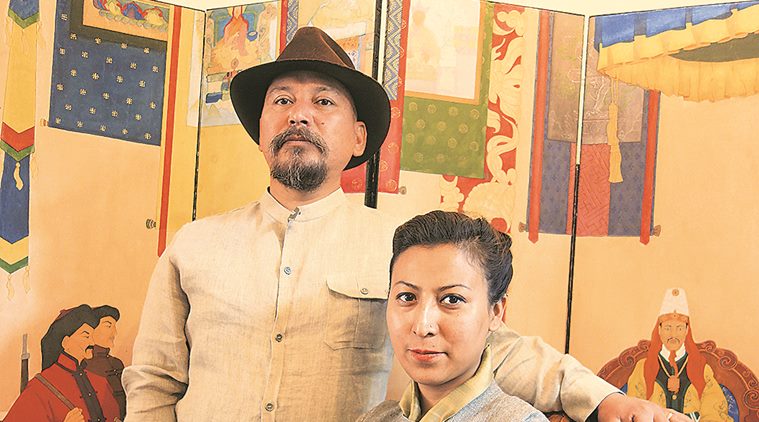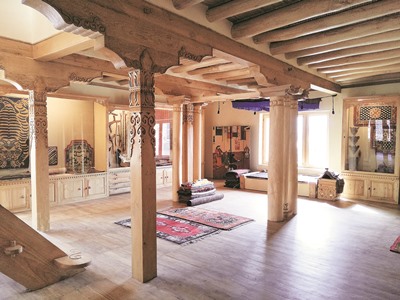 A design by Jigmat Couture
A design by Jigmat Couture
The beginning of an extraordinary story of a small fashion brand started with the objective to revive, preserve and promote the textile art, craft and traditional way of life in the remote mountains of the Himalayas, Ladakh to be precise,” says Jigmat Norbo, who with his wife Jigmat Wangmo, set out to create an industry from local resources.
Jigmat Couture was established in 2010, following two years of research on possibilities of woollen textiles in traditional weaves as a marketable product. Though weaving was not unknown to Ladakh, there were limitations and constraints in terms of the weave, design and innovation and the objective. Norbo decided to explore possibilities and create valuable products for a luxury market. In 2008, along with few artisans, the two worked on the creation of local woollen textiles (snam-bu) ,which resulted in beautifully textured and durable products. “The outcome was beyond expectation. We thought it was time to launch,” explains Norbo, who is visiting Chandigarh for a seminar at University Institute of Fashion Technology, Panjab University.
 Jigmat Norbo (left) and Jigmat Wangmo
Jigmat Norbo (left) and Jigmat Wangmo
Norbo studied fashion and spent time in the industry in Delhi, but always wanted to go back home and promote the art and craft of the place. The first challenge for Norbo and Wangmo was to train the locals in Ladakh, teach them new skills and techniques, and to introduce new concepts that would be beneficial to the community.
Some of the finest quality of wool is found in Ladakh, but the locals, rues Norbo, were not reaping any economic benefits except for selling the wool’s fibres as raw materials at below commodity prices. The art of weaving, once practiced in almost every house, was dying. “So it became our responsibility not only to sustain the art, but also to practice and promote it. That’s the thought that guides our projects, like creating innovative products in traditional weaves, extraordinary textiles and exceptional products that link remote Ladakh to the world. Building a base for local economy, the idea is to capitalise on the rich raw materials we have in Ladakh, for the benefit of the community, generating employment, preserving traditional art and craft for future generations,” says Norbo.
 The Textile Museum building
The Textile Museum building
The textiles and products are a combination of tradition and innovation. The artisans use traditional drop spindles and hand spindles to spin the wool. To weave, they use traditional foot loom and back-strap loom without changing the ancient aesthetic of the weave. The aim is to capitalise on resources and craft by transforming them in Ladakh itself, generating employment, bringing life back to dwindling village communities and letting the young generations understand the scope of the area, besides the tourism industry.
Keeping in sync with the philosophy of their work, Norbo and his wife have now established the first textile museum of Ladakh, which opened its doors to the public recently. “We felt a need to set up a place where one can simultaneously study, experience, apprenticeship and receive training in traditional textile art forms. A part of our profit goes into art and artisan skill development workshops and research projects and the museum will not only benefit Ladakhi people, but all those who wish to practice traditional arts,” says Norbo.
The museum in Leh has been constructed using all important elements of a Ladakhi architecture and local materials, with wood carvings which have textile motifs. The building has three levels. The first level has the museum, second houses Jigmat Couture studio and the third has a workshop for traditional spinning, weaving and dyeing, along with a large section for books and resource materials. On one side of the museum is a heritage house which was once used as a sarai during the silk route trade and now is being used as a private art gallery.
 Interiors of the museum
Interiors of the museum
The museum, explains Norbo, displays a variety of costumes and textiles either woven in Ladakh or which reached Ladakh through trade routes. “The textile collection and ancient artifacts will provide all visitors an opportunity to understand the rich traditions of Ladakh. The museum will provide a platform to students to study and give local artisans a space to explore creative possibilities,” says Norbo, adding that the exhibits include a variety of ancient articles for daily use along with traditional costumes created by Ladakhi people over successive generations. “The museum welcomes school children and art lovers for various workshops and we hope to be sustainable in order to expand our creative possibilities,” adds Norbo.